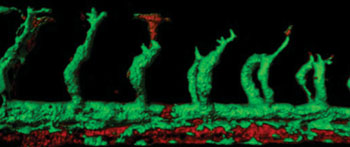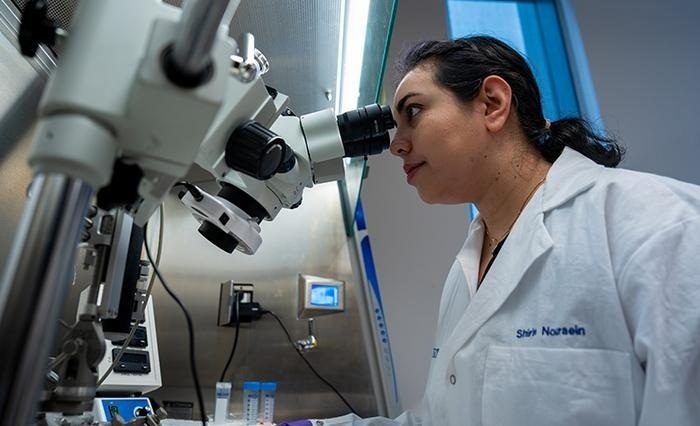Research on Zebrafish Embryos Reveals Origin of the Lymphatic System
|
By LabMedica International staff writers Posted on 03 Jun 2015 |

Image: Zebrafish embryos with fluorescent blood vessels helped solve the mystery regarding the origin of the lymphatic system (Photo courtesy of the Weizmann Institute of Science).
A team of developmental biologists working with a zebrafish embryo model system has located the site of origin of the lymphatic system and identified a gene critical to the differentiation of stem cells into mature lymphatic cells.
Investigators at the Weizmann Institute of Science (Rehovot, Israel) exploited the transparent bodies of zebrafish embryos to document development in real time over a period of several days. By reversing the direction of the video images, they were able to determine that the cells giving rise to lymphatic vessels always originated in a niche of angioblasts localized at the same part of the embryo's major vein.
Zooming in to the molecular level, the investigators identified the Wnt5b protein as a novel lymphatic inductive signal in the zebrafish embryos and further showed that it promoted the "angioblast-to-lymphatic" transition in human embryonic stem cells as well. Wnt5b in humans is encoded by the WNT5B (Wingless-type MMTV integration site family, member 5B) gene. The WNT gene family consists of structurally related genes that encode secreted signaling proteins. These proteins have been implicated in oncogenesis and in several developmental processes, including regulation of cell fate and patterning during embryogenesis.
Writing in the May 20, 2015, online edition of the journal Nature, the investigators reported that addition of Wnt5b to cultures of human embryonic stem cells induced those cells to differentiate into lymphatic cells—possibly the first time such cells had been grown in a laboratory.
"We started out by imaging zebrafish, and ended up finding a factor that makes it possible to create lymphatic cells," said senior author Dr. Karina Yaniv, assistant professor of biological regulation at the Weizmann Institute of Science. "That is the beauty of research in developmental biology: The embryo holds the answers, and all we have to do is watch and learn."
Related Links:
Weizmann Institute of Science
Investigators at the Weizmann Institute of Science (Rehovot, Israel) exploited the transparent bodies of zebrafish embryos to document development in real time over a period of several days. By reversing the direction of the video images, they were able to determine that the cells giving rise to lymphatic vessels always originated in a niche of angioblasts localized at the same part of the embryo's major vein.
Zooming in to the molecular level, the investigators identified the Wnt5b protein as a novel lymphatic inductive signal in the zebrafish embryos and further showed that it promoted the "angioblast-to-lymphatic" transition in human embryonic stem cells as well. Wnt5b in humans is encoded by the WNT5B (Wingless-type MMTV integration site family, member 5B) gene. The WNT gene family consists of structurally related genes that encode secreted signaling proteins. These proteins have been implicated in oncogenesis and in several developmental processes, including regulation of cell fate and patterning during embryogenesis.
Writing in the May 20, 2015, online edition of the journal Nature, the investigators reported that addition of Wnt5b to cultures of human embryonic stem cells induced those cells to differentiate into lymphatic cells—possibly the first time such cells had been grown in a laboratory.
"We started out by imaging zebrafish, and ended up finding a factor that makes it possible to create lymphatic cells," said senior author Dr. Karina Yaniv, assistant professor of biological regulation at the Weizmann Institute of Science. "That is the beauty of research in developmental biology: The embryo holds the answers, and all we have to do is watch and learn."
Related Links:
Weizmann Institute of Science
Latest BioResearch News
- Genome Analysis Predicts Likelihood of Neurodisability in Oxygen-Deprived Newborns
- Gene Panel Predicts Disease Progession for Patients with B-cell Lymphoma
- New Method Simplifies Preparation of Tumor Genomic DNA Libraries
- New Tool Developed for Diagnosis of Chronic HBV Infection
- Panel of Genetic Loci Accurately Predicts Risk of Developing Gout
- Disrupted TGFB Signaling Linked to Increased Cancer-Related Bacteria
- Gene Fusion Protein Proposed as Prostate Cancer Biomarker
- NIV Test to Diagnose and Monitor Vascular Complications in Diabetes
- Semen Exosome MicroRNA Proves Biomarker for Prostate Cancer
- Genetic Loci Link Plasma Lipid Levels to CVD Risk
- Newly Identified Gene Network Aids in Early Diagnosis of Autism Spectrum Disorder
- Link Confirmed between Living in Poverty and Developing Diseases
- Genomic Study Identifies Kidney Disease Loci in Type I Diabetes Patients
- Liquid Biopsy More Effective for Analyzing Tumor Drug Resistance Mutations
- New Liquid Biopsy Assay Reveals Host-Pathogen Interactions
- Method Developed for Enriching Trophoblast Population in Samples
Channels
Clinical Chemistry
view channel
Chemical Imaging Probe Could Track and Treat Prostate Cancer
Prostate cancer remains a leading cause of illness and death among men, with many patients eventually developing resistance to standard hormone-blocking therapies. These drugs often lose effectiveness... Read more
Mismatch Between Two Common Kidney Function Tests Indicates Serious Health Problems
Creatinine has long been the standard for measuring kidney filtration, while cystatin C — a protein produced by all human cells — has been recommended as a complementary marker because it is influenced... Read moreMolecular Diagnostics
view channel
New Serum Marker-Editing Strategy to Improve Diagnosis of Neurological Diseases
Tracking gene-expression changes in the brain is crucial for understanding neurological diseases, yet current monitoring tools are invasive or unable to capture subtle activity shifts over time.... Read more
World’s First Genetic Type 1 Diabetes Risk Test Enables Early Detection
Type 1 Diabetes (T1D) affects more than eight million people worldwide, with numbers expected to rise sharply. While most cases are genetically driven, only one in ten patients has a family history, making... Read moreHematology
view channel
Platelet Activity Blood Test in Middle Age Could Identify Early Alzheimer’s Risk
Early detection of Alzheimer’s disease remains one of the biggest unmet needs in neurology, particularly because the biological changes underlying the disorder begin decades before memory symptoms appear.... Read more
Microvesicles Measurement Could Detect Vascular Injury in Sickle Cell Disease Patients
Assessing disease severity in sickle cell disease (SCD) remains challenging, especially when trying to predict hemolysis, vascular injury, and risk of complications such as vaso-occlusive crises.... Read more
ADLM’s New Coagulation Testing Guidance to Improve Care for Patients on Blood Thinners
Direct oral anticoagulants (DOACs) are one of the most common types of blood thinners. Patients take them to prevent a host of complications that could arise from blood clotting, including stroke, deep... Read moreImmunology
view channel
Gene Signature Test Predicts Response to Key Breast Cancer Treatment
DK4/6 inhibitors paired with hormone therapy have become a cornerstone treatment for advanced HR+/HER2– breast cancer, slowing tumor growth by blocking key proteins that drive cell division.... Read more
Chip Captures Cancer Cells from Blood to Help Select Right Breast Cancer Treatment
Ductal carcinoma in situ (DCIS) accounts for about a quarter of all breast cancer cases and generally carries a good prognosis. This non-invasive form of the disease may or may not become life-threatening.... Read moreMicrobiology
view channelRapid POC Tuberculosis Test Provides Results Within 15 Minutes
Tuberculosis remains one of the world’s deadliest infectious diseases, and reducing new cases depends on identifying individuals with latent infection before it progresses. Current diagnostic tools often... Read more
Rapid Assay Identifies Bloodstream Infection Pathogens Directly from Patient Samples
Bloodstream infections in sepsis progress quickly and demand rapid, precise diagnosis. Current blood-culture methods often take one to five days to identify the pathogen, leaving clinicians to treat blindly... Read morePathology
view channelAI Tool Outperforms Doctors in Spotting Blood Cell Abnormalities
Diagnosing blood disorders depends on recognizing subtle abnormalities in cell size, shape, and structure, yet this process is slow, subjective, and requires years of expert training. Even specialists... Read more
AI Tool Rapidly Analyzes Complex Cancer Images for Personalized Treatment
Complex digital biopsy images that typically take an expert pathologist up to 20 minutes to assess can now be analyzed in about one minute using a new artificial intelligence (AI) tool. The technology... Read moreTechnology
view channel
AI Saliva Sensor Enables Early Detection of Head and Neck Cancer
Early detection of head and neck cancer remains difficult because the disease produces few or no symptoms in its earliest stages, and lesions often lie deep within the head or neck, where biopsy or endoscopy... Read more
AI-Powered Biosensor Technology to Enable Breath Test for Lung Cancer Detection
Detecting lung cancer early remains one of the biggest challenges in oncology, largely because current tools are invasive, expensive, or unable to identify the disease in its earliest phases.... Read moreIndustry
view channel
Abbott Acquires Cancer-Screening Company Exact Sciences
Abbott (Abbott Park, IL, USA) has entered into a definitive agreement to acquire Exact Sciences (Madison, WI, USA), enabling it to enter and lead in fast-growing cancer diagnostics segments.... Read more









 assay.jpg)
















